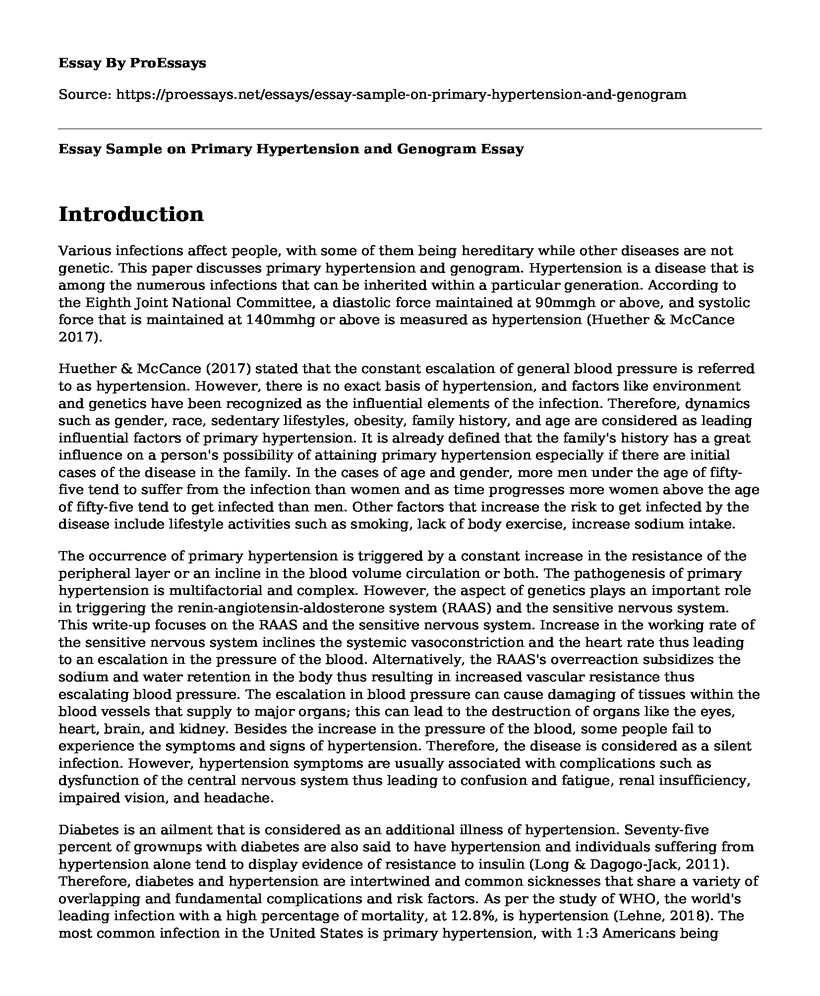Introduction
Various infections affect people, with some of them being hereditary while other diseases are not genetic. This paper discusses primary hypertension and genogram. Hypertension is a disease that is among the numerous infections that can be inherited within a particular generation. According to the Eighth Joint National Committee, a diastolic force maintained at 90mmgh or above, and systolic force that is maintained at 140mmhg or above is measured as hypertension (Huether & McCance 2017).
Huether & McCance (2017) stated that the constant escalation of general blood pressure is referred to as hypertension. However, there is no exact basis of hypertension, and factors like environment and genetics have been recognized as the influential elements of the infection. Therefore, dynamics such as gender, race, sedentary lifestyles, obesity, family history, and age are considered as leading influential factors of primary hypertension. It is already defined that the family's history has a great influence on a person's possibility of attaining primary hypertension especially if there are initial cases of the disease in the family. In the cases of age and gender, more men under the age of fifty-five tend to suffer from the infection than women and as time progresses more women above the age of fifty-five tend to get infected than men. Other factors that increase the risk to get infected by the disease include lifestyle activities such as smoking, lack of body exercise, increase sodium intake.
The occurrence of primary hypertension is triggered by a constant increase in the resistance of the peripheral layer or an incline in the blood volume circulation or both. The pathogenesis of primary hypertension is multifactorial and complex. However, the aspect of genetics plays an important role in triggering the renin-angiotensin-aldosterone system (RAAS) and the sensitive nervous system. This write-up focuses on the RAAS and the sensitive nervous system. Increase in the working rate of the sensitive nervous system inclines the systemic vasoconstriction and the heart rate thus leading to an escalation in the pressure of the blood. Alternatively, the RAAS's overreaction subsidizes the sodium and water retention in the body thus resulting in increased vascular resistance thus escalating blood pressure. The escalation in blood pressure can cause damaging of tissues within the blood vessels that supply to major organs; this can lead to the destruction of organs like the eyes, heart, brain, and kidney. Besides the increase in the pressure of the blood, some people fail to experience the symptoms and signs of hypertension. Therefore, the disease is considered as a silent infection. However, hypertension symptoms are usually associated with complications such as dysfunction of the central nervous system thus leading to confusion and fatigue, renal insufficiency, impaired vision, and headache.
Diabetes is an ailment that is considered as an additional illness of hypertension. Seventy-five percent of grownups with diabetes are also said to have hypertension and individuals suffering from hypertension alone tend to display evidence of resistance to insulin (Long & Dagogo-Jack, 2011). Therefore, diabetes and hypertension are intertwined and common sicknesses that share a variety of overlapping and fundamental complications and risk factors. As per the study of WHO, the world's leading infection with a high percentage of mortality, at 12.8%, is hypertension (Lehne, 2018). The most common infection in the United States is primary hypertension, with 1:3 Americans being diagnosed with the disease per year (Huether & McCance, 2017). Huether & McCance (2017) stated that above two-thirds of the infected individuals are above sixty years.
References
Huether, S.E., McCance, K.L. (2017). Understanding Pathophysiology (6th ed.). St. Louis, MO. Elsevier. ISBN: 978-0323354097
Lehne, R.A. (2018). Pharmacology for Nursing Care (10th ed.). St. Louis, MO. Elsevier. ISBN: 978-0323512275
Long, A. N., & Dagogo-Jack, S. (2011). Comorbidities of diabetes and hypertension: mechanisms and approach to target organ protection. Journal of clinical hypertension (Greenwich, Conn.), 13(4), 244-51.
Cite this page
Essay Sample on Primary Hypertension and Genogram. (2022, Dec 01). Retrieved from https://proessays.net/essays/essay-sample-on-primary-hypertension-and-genogram
If you are the original author of this essay and no longer wish to have it published on the ProEssays website, please click below to request its removal:
- Health Sector's Cooperation with External Agencies - Essay Sample on Public Health
- Childhood Obesity: Causes and Consequences
- Group Protocol Assignment: Dealing With Physical Disability in Older Adults in the Long-Term Rehab
- Essay Sample on Health Maintenance and Screening Plans
- Essay Sample on Obesity Among African Americans in Fort Worth, Texas
- Essay Sample on the Benefits of Community Public Health Officers
- Research Paper on UK Welfare State: Quality Healthcare, Social Security & Education







